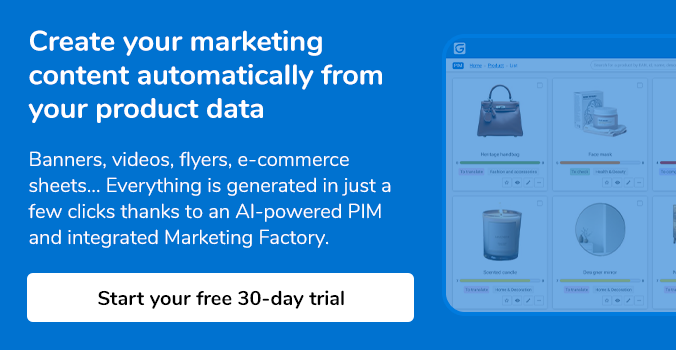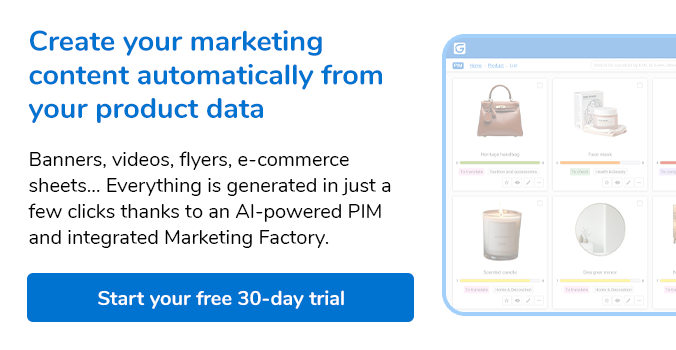Data management is a major preoccupation for businesses. 84% of business leaders1 are preoccupied by the quality of the data that their decisions are based on.
At any given time, a business must have access to accurate, reliable, and high-quality data to make the best strategic and operational decisions. Data therefore needs to be managed with particular care.
To achieve this, it has become essential to implement specialized data management software, among which PIM (Product Information Management) and MDM (Master Data Management). While they are often presented as opposing solutions, PIM and MDM share many features and both provide a guarantee of a company's data quality.
Find out all you need to know to help you choose the data management solution best suited to your needs.
#PIM and MDM, control your data
#MDM, purpose and definition
Businesses often rely on a number of different systems and applications to manage their data: ERP (accounting, human resources, stocks…), CRM (customers), Excel (marketing)… This dispersal of data has a negative impact on productivity and increases the risks of errors: time wasted searching for data, inconsistencies, duplicates, incomplete and/or missing information… the problems relating to data quality are a major concern for businesses. 70% of them2 feel that these issues impact their activity negatively.

In answer to this, MDM software (Master Data Management) is a central reference source for all the company's divisions. The MDM centralizes and consolidates all the data used by the different divisions, employees, suppliers, partners, accounting, human resources… A workflow engine also enables each team, according to their user rights, to clean, enrich and/or validate their data. This data is the company's reference source or master data.
MDM provides a real competitive advantage. Following its implementation, businesses have observed numerous improvements3: ROI (56%), quality of data for decision making (55%), operational efficiency (45%)…
#PIM, purpose and definition
In a company, product data is often scattered among several different information sources: ERP (Enterprise Resource Planning), CRM (Customer Relationship Management), Files in different formats (Excel, XML, Json…)…
Working with scattered data increases the risk of errors in product information and has a negative impact on sales: disappointed customers, increased product returns, and cart abandonment… 50% of shoppers4 have returned a product because it did not match its product description.
To rectify this, PIM software (Product Information Management) greatly improves the quality of product information. PIM centralizes all product data while its multi-user management features allow each contributor, depending on their user rights, to contribute to the quality of product information: correct, enrich, check... With PIM, Product and Marketing teams can always rely on a unique data source containing the most reliable and up-to-date version of their data.
#PIM vs MDM: a false debate
The boundaries between PIM software (Product Information Management) and MDM software (Master Data Management) are blurry. They are both unique and central data repositories, designed to guarantee the quality and reliability of a company's data. PIM and MDM have a lot of features in common: centralization, multi-user management, task automation, synchronization…

There are also similarities in how PIM and MDM are used. MDM tools manage all a company's data, including product related data (marketing, logistics, technical…). In managing product information, the MDM works as a “PIM repository”.
Similarly, PIM has some of the features of MDM (Master Data Management) software. PIM has features to manage product related information, allowing it to increase its scope and to manage other company data: suppliers, ranges, collections, distributors, customers… With PIM, the various teams (Product, Marketing, SEO, eCommerce…) can use the same centralized product data source containing the right product data and all other relevant information.
#PIM and MDM: Choose the best one for you
MDM software (Master Data Management) covers a wider scope, providing all company activities with a 360° view of data. The more specific PIM software (Product Information Management) has advanced features to manage product data and provide solutions to the numerous challenges of eCommerce.
The features provided by PIM (Product Information Management) and MDM (Master Data Management) software vary greatly from one solution to another and several solutions match both definitions. When it comes down to it, what counts is how you use the solution.
To choose the most suitable solution for you, the important thing to look at is how its features fit your requirements.
1Forbes. (2017, 31 may). Poor-Quality Data Imposes Costs and Risks on Businesses, Says New Forbes Insights Report.
2Kaak, R. K. (2019, 4 november). L'IA au service de la qualité des données, pour des cas d'usage toujours plus innovants.
3Wavestone. Les Master Data, Un levier pour exceller ?
4Chrum, A. C. 10 Stats That Prove the Importance of Product Content for E-commerce [Infographic].







